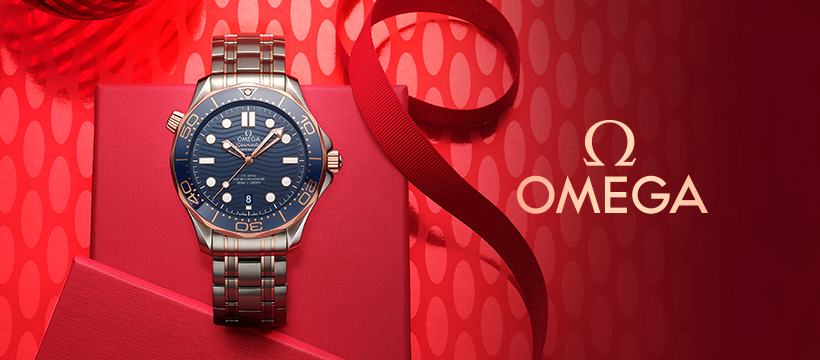
Omega
Swiss luxury watch brand
Contents
Summary
Swiss luxury watch brand Omega is celebrated for its precision, innovation, and timeless design. Established in 1848 by Louis Brandt, Omega has become a symbol of horological excellence, gaining global recognition for its role in pivotal moments of history, including being the official timekeeper of the Olympic Games and the first watch on the moon with the iconic Speedmaster. Known for its masterful craftsmanship and groundbreaking technologies, such as the Co-Axial escapement, Omega’s collections, including the Seamaster, Constellation, and De Ville, appeal to both watch connoisseurs and modern luxury enthusiasts.
History
The predecessor of Omega, La Generale Watch Co., was set up at La Chaux-de-Fonds, Switzerland in 1848 by Louis Brandt who made key-wound precision pocket watches from parts supplied by craftsmen and then sold it throughout Europe. In 1892, Louis Brandt crafted the world’s first minute-repeater wristwatch in collaboration with Audemars Piguet, now showcased at Omega Museum, Biel- Bienne, Switzerland. In 1894, his sons Louis-Paul and César moved to larger premises in Biel-Bienne and developed a manufacturing technique which allowed components to be interchangeable. Wristwatches made with this technique were promoted under the brand name, Omega. By 1903, its growth trajectory led La Generale Watch Co to rebrand it as Omega Watch Co. Shortly, the first wristwatches with the name Omega were introduced. British armed forces wore it during South Africa’s Boer War and stated that its performance was unrivalled in severe cold, heat, rain and sandstorm.
Louis-Paul and César Brandt both passed away in 1903. The company at the time was one of Switzerland’s largest, with eight hundred employees and production of 240,000 watches each year. It was inherited by their sons. The oldest, twenty-four year-old Paul-Emile Brandt, took over the reins. Omega set precision records on all six trials at Geneva Observatory. And made its debut as official timekeeper at Olympic Games 1932. The alliance continues till date. The brand’s hundredth anniversary celebrations witnessed the launch of the iconic ‘Seamaster’. Ranging from modern diving aids to vintage inspired chronographs, it combined all innovations into one watch.
‘Speedmaster’ was developed by Albert Piguet in 1946 after it was conceptualized by Jacques Reymond. The features were a water-resistant case, black dial, screwed back, domed Plexiglas crystal, luminous hands and a tachymeter scale. It is one of the most important timepieces in the Omega constellation. In 1962, it went down in history when astronaut Wally Schirra wore it on the Mercury Sigma 7 Mission. In 1969, Omega Speedmaster was a part of the first trip to the moon, worn on the wrist of astronaut Buzz Aldrin. Omega Speedmaster Professional Chronograph also made history when it helped the crew of Apollo 13 to navigate safely back to earth, for which it received the highest distinction from NASA. With onboard computers not working and most electrical systems shut down to conserve energy, James Lovell turned to Omega Speedmaster to time a fourteen-second fuel burn in order to change the direction of the capsule for re-entry into the earth’s atmosphere. Even today, Omega continues to work with space programs to create some of the most effective tools in the business.
By the late Seventies, the mechanical watch industry was nearing extinction due to the rise of the Japanese quartz movement. In 1983, ASUAG-SSIH was formed from two financially troubled companies, ASUAG and SSIH. Taken private in 1985 by investors led by industrial troubleshooter Nicolas Hayek , it was renamed Société de Microélectronique et d’Horlogerie in 1986 and then The Swatch Group. The success of his plan, as co-founder, CEO and Chairman of the Board of The Swatch Group, a plastic-covered quartz timepiece aimed at the masses, ensured the survival of Omega. The Swatch Group now manufactures Omega, Blancpain, Swatch and Breguet.
Omega’s growth was supported by a formidable marketing plan. The brand appeared in James Bond films ever since Pierce Brosnan wore Seamaster Diver 300 in ‘GoldenEye.’ Al Pacino’s character in ‘Scarface’ wore Omega La Magique. The brand also made headlines when signing supermodel Cindy Crawford as brand ambassador. Omega then opened several boutiques in 2017 and unveiled its new production facility in Bienne, with a testing area overseen by Swiss Federal Institute Of Meteorology. Per Forbes, “Legacy brands like Omega that are willing to creatively adapt their core message with new talent to reach core customers and new consumers alike will be the brands that survive and thrive in the digital age.”
Vision
Innovative watchmaking is the cornerstone of luxury brand Omega’s heritage. This legacy is deeply inspired by its role in sports timekeeping, where precision and excellence are paramount. Omega’s commitment to pushing boundaries is exemplified through its pioneering spirit, both in technical advancements and in its dedication to supporting some of the world’s most prestigious events and organizations. From the Olympics to major sporting events worldwide, Omega has established itself as a leader in measuring time with unmatched accuracy.
Beyond sports, Omega has ventured into realms that few other watchmakers have dared to explore. Its conquests in space are a testament to the luxury brand’s relentless pursuit of perfection and durability under extreme conditions. Omega watches have accompanied astronauts on historic missions, proving their reliability and resilience. The luxury brand also champions causes aligned with its values, advocating for environmental sustainability and supporting charitable organizations, subsequently extending its influence beyond mere timekeeping.
Mission
Luxury brand Omega’s mission focuses on a steadfast commitment to innovation and quality. The company strives to offer exceptional service by delivering high-quality and secure IT systems and solutions tailored to meet the unique needs of its clients. By harnessing the latest technological advancements, Omega ensures that its solutions are not only robust and reliable but also strategically aligned with its clients’ business objectives. This approach empowers clients to navigate complex digital landscapes, optimize their operations, and achieve sustainable growth.
At the heart of Omega’s mission is a dedication to excellence in every aspect of its service. The company’s core team is driven by an unwavering work ethic, continuously pushing the boundaries of what is possible in the IT sector. Their commitment to professional excellence is guided by a set of well-defined Core Values that emphasize integrity, innovation, and customer-centricity. These values serve as the foundation for building strong, lasting relationships with clients, partners, and stakeholders.
Products and Services
Omega has solidified its reputation as a leader in the world of luxury timepieces through its collection of iconic watches. The Omega Speedmaster, often referred to as the “Moonwatch,” gained worldwide recognition when it was worn by astronauts during the Apollo 11 mission in 1969. As the first watch to be worn on the moon, the Speedmaster became a symbol of precision and endurance, captivating the imaginations of watch enthusiasts and collectors alike. Its robust construction, reliable movement, and timeless design have made it a staple for those seeking a piece of horological history on their wrist.
Another standout in Omega’s lineup is the Seamaster, famously associated with the James Bond franchise. With its sleek design, exceptional water resistance, and advanced technology, the Seamaster has become synonymous with adventure and sophistication. This model, first introduced in 1948, showcases Omega’s commitment to innovation and quality craftsmanship. Whether it’s the vintage appeal of the Seamaster 300 or the modern allure of the Seamaster Diver 300M, this series continues to set the benchmark for professional dive watches, embodying a perfect blend of functionality and elegance.
Team
Raynald Aeschlimann (President and CEO)
Dr. Nayla Hayek (Chair of the Board of Directors of Swatch Group)
Ernst Tanner (Vice-Chairman of the Board of Directors of Swatch Group)
Nick Hayek (President of the Executive Group Management Board of Swatch Group)
Awards and Recognition
Omega has achieved unparalleled recognition as a global leader in luxury watchmaking, celebrated for its precision, innovation, and historical significance. Renowned as the official timekeeper for the Olympic Games since 1932, Omega’s commitment to accuracy has set a gold standard in sports and horology. Its pioneering achievements, such as the development of the Co-Axial escapement and the production of the first watch to be worn on the moon, have cemented its reputation for technological excellence. Omega’s watches are not only symbols of luxury but also trusted instruments of performance, worn by explorers, athletes, and astronauts alike. This enduring recognition reflects the brand’s ability to merge timeless elegance with cutting-edge technology, making it a hallmark of Swiss craftsmanship and innovation.
References
- Official website Omega
- Which Omega Speedmaster Went to the Moon? Swiss Watch Expo
- Twitter profile of Omega Twitter
- Omega debuts next generation of NASA-qualified Speedmaster moon watches Space.com
- LinkedIn profile of Omega LinkedIn
- Omega museum Omega
- Instagram profile of Omega Instagram
- Omega Speedmaster Professional Chronographs Omega
- Youtube profile of Omega Youtube
- From Apollo 11 to James Bond Watch Time
- Wikipedia profile of Omega Wikipedia
- Omega vs Rolex: Which Should You Buy? Blowers
- The countdown clock is clicking again for the Tokyo Olympics USA Today
- New Record Set for Most Expensive Omega Wristwatch Revolution Watch
- Omega’s latest collection of watches GQ
- The first watch worn on the moon World Tempus
- Omega: A Legacy Brand Looks To The Future And Celebrates Its Past Forbes
- Highlights of Olympic timeKeeping Omega
- Omega’s hottest new creations costs just £165 GQ
- New Omega Speedmaster Moonwatch – a Piece of Space History Omega




